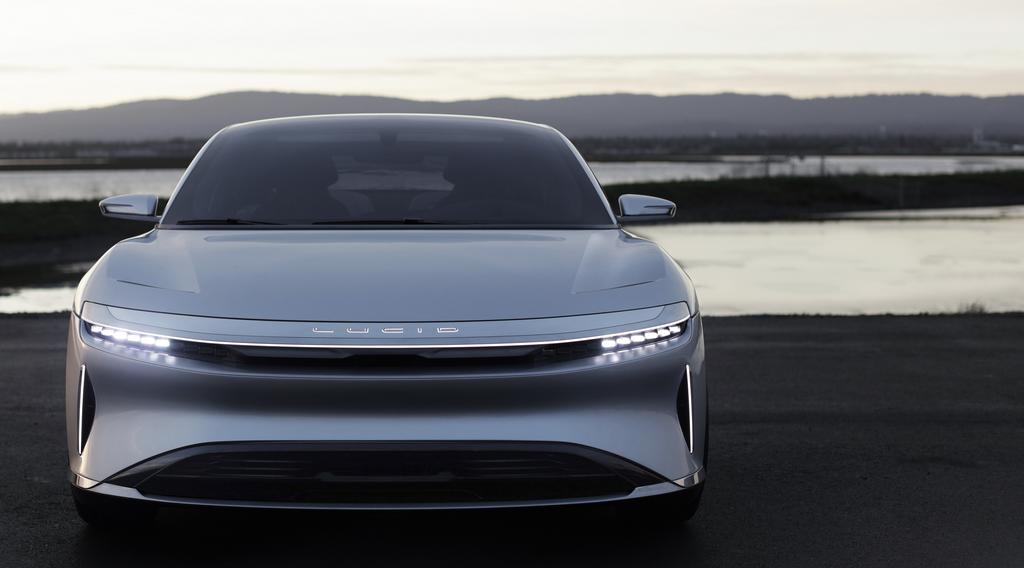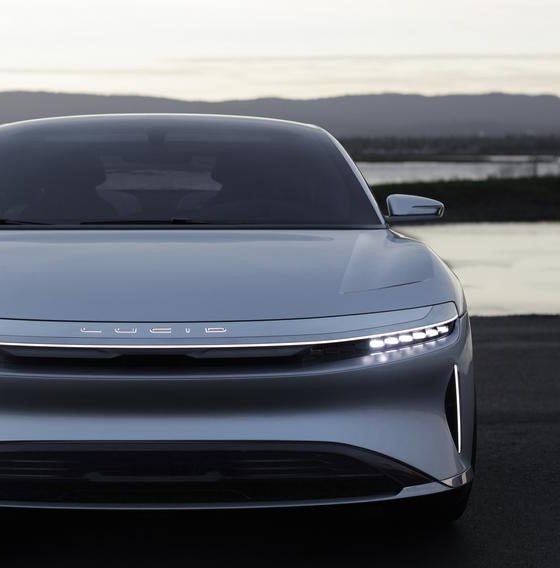

News
Land for Lucid Motors Arizona factory will reportedly be paid by tax payers
Officials in Pinal County, Arizona are considering ways to raise the money needed to purchase 500 acres of land near the city of Casa Grande where Lucid Motors intends to build its $700 million electric car factory. The proposed manufacturing facility was the subject of a high profile press event earlier this month that featured Arizona governor Doug Ducey. All parties acknowledge Ducey was a key player in landing the project for the state of Arizona.
There is only one problem with the deal — the taxpayers of Arizona are expected to pay for the purchase of the land and contribute a significant amount of money to help it get the factory built and operational. When and if everything goes as planned, the factory is expected to create 2,000 jobs in an area where many are unemployed or underemployed.
The land itself will cost $31.8 million, Financing the purchase over 30 years will add another $41.6 million, but Pinal County spokesperson Joe Pyritz says the plan is to lease the land after is is purchased (presumably to Lucid Motors, although the county is not allowed to say so for the record) and then sell it at the end of 5 years. That arrangement would cap the total cost of the deal at $35 million. The sale price is expected to equal the total outlay made by the county for principal and interest.
However, first someone has to actually buy the land. County supervisors will meet in January to consider how to do that. The leading proposal is to finance the purchase by raising property taxes or imposing a countywide sales tax surcharge. Pyritz says if the supervisors decide on a tax increase, the new tax would only cover the land deal and would end once the tax funding reimburses the county for the purchase cost.
Lucid will get other sweeteners to bring its business to Pinal County. The project involves what the Phoenix New Times calls “a significant amount of corporate welfare.” Lucid Motors will be eligible for up to $46.5 million in various subsidies offered by the state through the Arizona Commerce Authority over the next five years. Those subsidies will be coupled with certain performance targets.
The subsidies include:
- $5 million in grant money over five years, dependent on meeting specified job-creation and capital-investment milestones.
- $1.5 million in grant money for job training. The company would pay for the cost of training employees and the state would reimburse 75 percent of the cost over two years.
- $40 million in refundable tax credits under the Qualified Facility Tax Credit Program the legislature created in 2012.
Susan Marie, spokeswoman for the Arizona Commerce Authority is quick to point out that the total amount is far less than the $335 million in tax credits promised to Faraday Future or the $1.3 billion in similar credits promised to Tesla Motors by the state of Nevada.
Lucid revealed its 1,000 horsepower proposed production car — the Lucid Air — last week. The 4 door sedan is said to have up to a 135 kWh battery capacity and capable of driving 400 miles per single charge. The result is something that tops Tesla’s flagship Model S P100D and by a considerable margin. Does that mean Lucid will win customers away from Tesla?
That’s unlikely. Granted that Lucid may have an edge in some areas, it lacks a charging infrastructure. Without something comparable to Tesla’s Supercharger network while having no brand recognition, peeling customers away from Tesla will be a lot harder than just offering a larger battery. But first, Lucid needs to build a factory. That first step is far from guaranteed despite lofty promises form the company.

Elon Musk
Elon Musk and Tesla AI Director share insights after empty driver seat Robotaxi rides
The executives’ unoccupied tests hint at the rapid progress of Tesla’s unsupervised Robotaxi efforts.

Tesla CEO Elon Musk and AI Director Ashok Elluswamy celebrated Christmas Eve by sharing personal experiences with Robotaxi vehicles that had no safety monitor or occupant in the driver’s seat. Musk described the system’s “perfect driving” around Austin, while Elluswamy posted video from the back seat, calling it “an amazing experience.”
The executives’ unoccupied tests hint at the rapid progress of Tesla’s unsupervised Robotaxi efforts.
Elon and Ashok’s firsthand Robotaxi insights
Prior to Musk and the Tesla AI Director’s posts, sightings of unmanned Teslas navigating public roads were widely shared on social media. One such vehicle was spotted in Austin, Texas, which Elon Musk acknowleged by stating that “Testing is underway with no occupants in the car.”
Based on his Christmas Eve post, Musk seemed to have tested an unmanned Tesla himself. “A Tesla with no safety monitor in the car and me sitting in the passenger seat took me all around Austin on Sunday with perfect driving,” Musk wrote in his post.
Elluswamy responded with a 2-minute video showing himself in the rear of an unmanned Tesla. The video featured the vehicle’s empty front seats, as well as its smooth handling through real-world traffic. He captioned his video with the words, “It’s an amazing experience!”
Towards Unsupervised operations
During an xAI Hackathon earlier this month, Elon Musk mentioned that Tesla owed be removing Safety Monitors from its Robotaxis in Austin in just three weeks. “Unsupervised is pretty much solved at this point. So there will be Tesla Robotaxis operating in Austin with no one in them. Not even anyone in the passenger seat in about three weeks,” he said. Musk echoed similar estimates at the 2025 Annual Shareholder Meeting and the Q3 2025 earnings call.
Considering the insights that were posted Musk and Elluswamy, it does appear that Tesla is working hard towards operating its Robotaxis with no safety monitors. This is quite impressive considering that the service was launched just earlier this year.
Elon Musk
Starlink passes 9 million active customers just weeks after hitting 8 million
The milestone highlights the accelerating growth of Starlink, which has now been adding over 20,000 new users per day.

SpaceX’s Starlink satellite internet service has continued its rapid global expansion, surpassing 9 million active customers just weeks after crossing the 8 million mark.
The milestone highlights the accelerating growth of Starlink, which has now been adding over 20,000 new users per day.
9 million customers
In a post on X, SpaceX stated that Starlink now serves over 9 million active users across 155 countries, territories, and markets. The company reached 8 million customers in early November, meaning it added roughly 1 million subscribers in under seven weeks, or about 21,275 new users on average per day.
“Starlink is connecting more than 9M active customers with high-speed internet across 155 countries, territories, and many other markets,” Starlink wrote in a post on its official X account. SpaceX President Gwynne Shotwell also celebrated the milestone on X. “A huge thank you to all of our customers and congrats to the Starlink team for such an incredible product,” she wrote.
That growth rate reflects both rising demand for broadband in underserved regions and Starlink’s expanding satellite constellation, which now includes more than 9,000 low-Earth-orbit satellites designed to deliver high-speed, low-latency internet worldwide.
Starlink’s momentum
Starlink’s momentum has been building up. SpaceX reported 4.6 million Starlink customers in December 2024, followed by 7 million by August 2025, and 8 million customers in November. Independent data also suggests Starlink usage is rising sharply, with Cloudflare reporting that global web traffic from Starlink users more than doubled in 2025, as noted in an Insider report.
Starlink’s momentum is increasingly tied to SpaceX’s broader financial outlook. Elon Musk has said the satellite network is “by far” the company’s largest revenue driver, and reports suggest SpaceX may be positioning itself for an initial public offering as soon as next year, with valuations estimated as high as $1.5 trillion. Musk has also suggested in the past that Starlink could have its own IPO in the future.
News
NVIDIA Director of Robotics: Tesla FSD v14 is the first AI to pass the “Physical Turing Test”
After testing FSD v14, Fan stated that his experience with FSD felt magical at first, but it soon started to feel like a routine.

NVIDIA Director of Robotics Jim Fan has praised Tesla’s Full Self-Driving (Supervised) v14 as the first AI to pass what he described as a “Physical Turing Test.”
After testing FSD v14, Fan stated that his experience with FSD felt magical at first, but it soon started to feel like a routine. And just like smartphones today, removing it now would “actively hurt.”
Jim Fan’s hands-on FSD v14 impressions
Fan, a leading researcher in embodied AI who is currently solving Physical AI at NVIDIA and spearheading the company’s Project GR00T initiative, noted that he actually was late to the Tesla game. He was, however, one of the first to try out FSD v14.
“I was very late to own a Tesla but among the earliest to try out FSD v14. It’s perhaps the first time I experience an AI that passes the Physical Turing Test: after a long day at work, you press a button, lay back, and couldn’t tell if a neural net or a human drove you home,” Fan wrote in a post on X.
Fan added: “Despite knowing exactly how robot learning works, I still find it magical watching the steering wheel turn by itself. First it feels surreal, next it becomes routine. Then, like the smartphone, taking it away actively hurts. This is how humanity gets rewired and glued to god-like technologies.”
The Physical Turing Test
The original Turing Test was conceived by Alan Turing in 1950, and it was aimed at determining if a machine could exhibit behavior that is equivalent to or indistinguishable from a human. By focusing on text-based conversations, the original Turing Test set a high bar for natural language processing and machine learning.
This test has been passed by today’s large language models. However, the capability to converse in a humanlike manner is a completely different challenge from performing real-world problem-solving or physical interactions. Thus, Fan introduced the Physical Turing Test, which challenges AI systems to demonstrate intelligence through physical actions.
Based on Fan’s comments, Tesla has demonstrated these intelligent physical actions with FSD v14. Elon Musk agreed with the NVIDIA executive, stating in a post on X that with FSD v14, “you can sense the sentience maturing.” Musk also praised Tesla AI, calling it the best “real-world AI” today.








